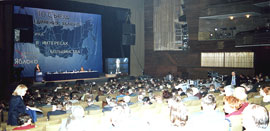YABLOKO conducted a round table on environmental problems of the Krasnoyarsk region
Press Release, May 28, 2013
On May 27, the Krasnoyarsk branch of the Green Russia environmental faction of the YABLOKO party and public environmental organisations of the Krasnoyarsk region conducted a round table “Ecological problems of the Krasnoyarsk Region” in Krasnoyarsk. The main topic of the meeting was the discussion of radioactive safety in the region in connection with government’s plans to build a repository for high-level and long-lived radioactive waste near Krasnoyarsk. 
Opening the round table meeting YABLOKO’s Chairman Sergei Mitrokhin stressed that control over radiation safety was traditionally one of the main priorities of YABLOKO’s environmental policies. He also said that despite the counteraction of the Krasnoyarsk authorities who refused to discuss these issues with representatives of the YABLOKO party at the round table organised by the Civil Assembly of the Krasnoyarsk region, the party would continue to consistently uphold the right of the citizens to a healthy environment and radiation safety.
Environmental situation in the region has been very unfavourable without construction of a repository for radioactive waste. “Fifteen years ago experts warned that radioactive waste pumped into soil may leak to the Yenisei River in a few years. Since then all the information on this issue has been closed from public by a special order, and today we do not have objective data on this issue,” Alexei Yablokov, Chair of the Green Russia faction, noted in his speech.
According to Alexander Nikitin, head of the nuclear and radiological safety programme of the Green Russia faction, construction of a radioactive waste repository near Krasnoyarsk raises a lot of questions requiring open and public discussion. He also stressed that Russia had accumulated enormous problems regarding spent nuclear fuel and radioactive waste. Nikitin said that Russia had 487 million cubic meters of radioactive waste, moreover adding to it 4 million cubic meters of “Russian” radioactive waste annually. 
“I have a suspicion that our nuclear scientists want to shift public attention onto purely technical issues, such as, for example, how and by what means the radiation safety of nuclear burial ground near Krasnoyarsk will be ensured,” said Alexander Kolotov, member of the Green Russia Krasnoyarsk branch. “In my opinion, we should begin with a discussion of fundamental strategic questions: for example, about the uniqueness of Nizhnekansky rocks and why the radioactive waste repository should be located here, in the immediate proximity to a three million city and not elsewhere in the Russian Federation?”
The discussion resulted in development of a number of recommendations on the provision of radioactive safety measures.
Posted: May 29th, 2013 under Protection of Environment, YABLOKO for Nuclear Safety.






